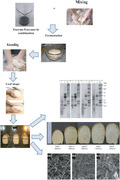- Record: found
- Abstract: found
- Article: found
Hydrolytic enzymes and their directly and indirectly effects on gluten and dough properties: An extensive review

Read this article at
Abstract
Poor water solubility, emulsifying, and foaming properties of gluten protein have limited its applications. Gluten is structured by covalent (disulfide bonds) and noncovalent bonds (hydrogen bonds, ionic bonds, hydrophobic bonds) which prone to alteration by various treatments. Enzyme modification has the ability to alter certain properties of gluten and compensate the deficiencies in gluten network. By hydrolyzing mechanisms and softening effects, hydrolytic enzymes affect gluten directly and indirectly and improve dough quality. The present review investigates the effects of some hydrolytic enzymes (protease and peptidase, alcalase, xylanase, pentosanase, and cellulase) on the rheological, functional, conformational, and nutritional features of gluten and dough. Overall, protease, peptidase, and alcalase directly affect peptide bonds in gluten. In contrast, arabinoxylan, pentosan, and cellulose are affected, respectively, by xylanase, pentosanase, and cellulase which indirectly affect gluten proteins. The changes in gluten structure by enzyme treatment allow gluten for being used in variety of purposes in the food and nonfood industry.
Abstract
The present review investigates the effects of some hydrolytic enzymes (protease and peptidase, alcalase, xylanase, pentosanase, and cellulase) on the rheological, functional, conformational, and nutritional features of gluten and dough. Overall, protease, peptidase, and alcalase directly affect peptide bonds in gluten. In contrast, arabinoxylan, pentosan, and cellulose are affected, respectively, by xylanase, pentosanase, and cellulase which indirectly affect gluten proteins. The changes in gluten structure by enzyme treatment allow gluten for being used in variety of purposes in the food and nonfood industry.
Related collections
Most cited references132
- Record: found
- Abstract: not found
- Article: not found
What vibrations tell about proteins
- Record: found
- Abstract: found
- Article: not found
Wheat gluten functionality as a quality determinant in cereal-based food products.
- Record: found
- Abstract: not found
- Article: not found
